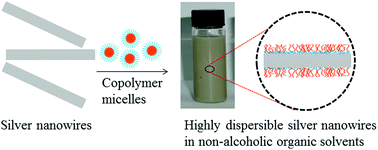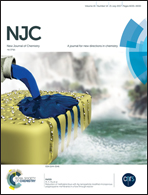Highly dispersible silver nanowires via a diblock copolymer approach for potential application in transparent conductive composites†
Abstract
We report here a facile and reproducible strategy for fabricating highly dispersible silver nanowires (AgNWs) in organic solvents using poly(methyl methacrylate)-b-poly(acrylic acid) (PMMA-b-PAA) diblock copolymers as the dispersant. The copolymers could be assembled into spherical micelles with PMMA as the core and the solvated PAA block as the corona in methanol. Interestingly, when the copolymer micelle solution was mixed with an AgNW dispersion in methanol, the AgNWs precipitated out within no more than a few minutes depending on the concentration of the micelle solution. The precipitate could readily be redispersed in common organic solvents such as chloroform, toluene, etc., which are good solvents for the PMMA block. The mechanism study revealed that while the PAA block served as an anchor that became chemically attached onto the surfaces of the AgNWs, the PMMA block formed a solvated “buoy” to allow the AgNWs to remain dispersed in the solvent. Transparent conductive glass (TCG) from the modified AgNWs and PMMA was also produced, suggesting that the modified AgNWs could also be well dispersed within the polymer matrix. Although there are reports on the preparation of dispersible inorganic particles using copolymers as a dispersant, the strategy reported in this article is believed to be novel, facile, and quite simple, and can be used as a concept and a universal tool for surface modification of other inorganic nanoparticles from specifically designed and prepared copolymers.



 Please wait while we load your content...
Please wait while we load your content...